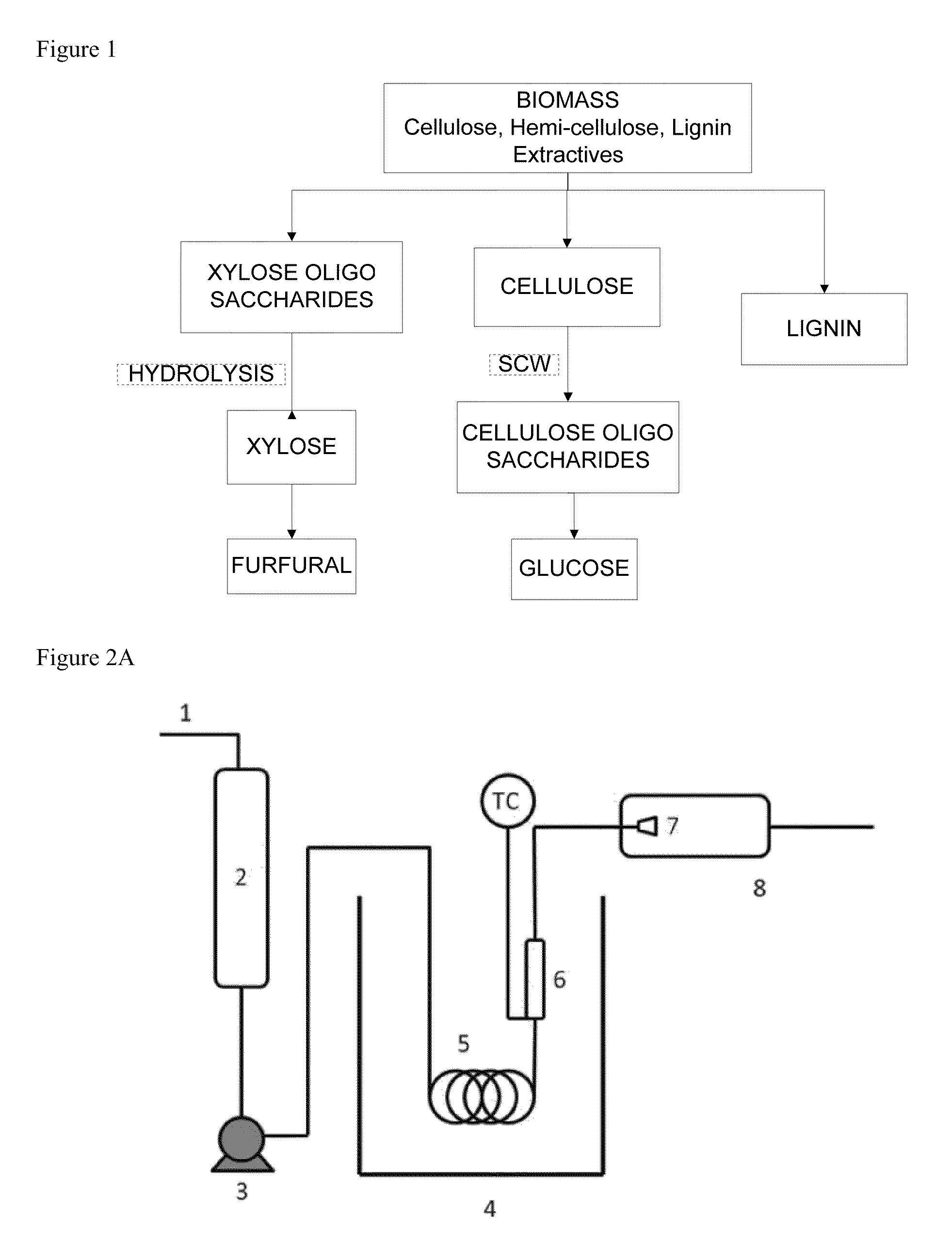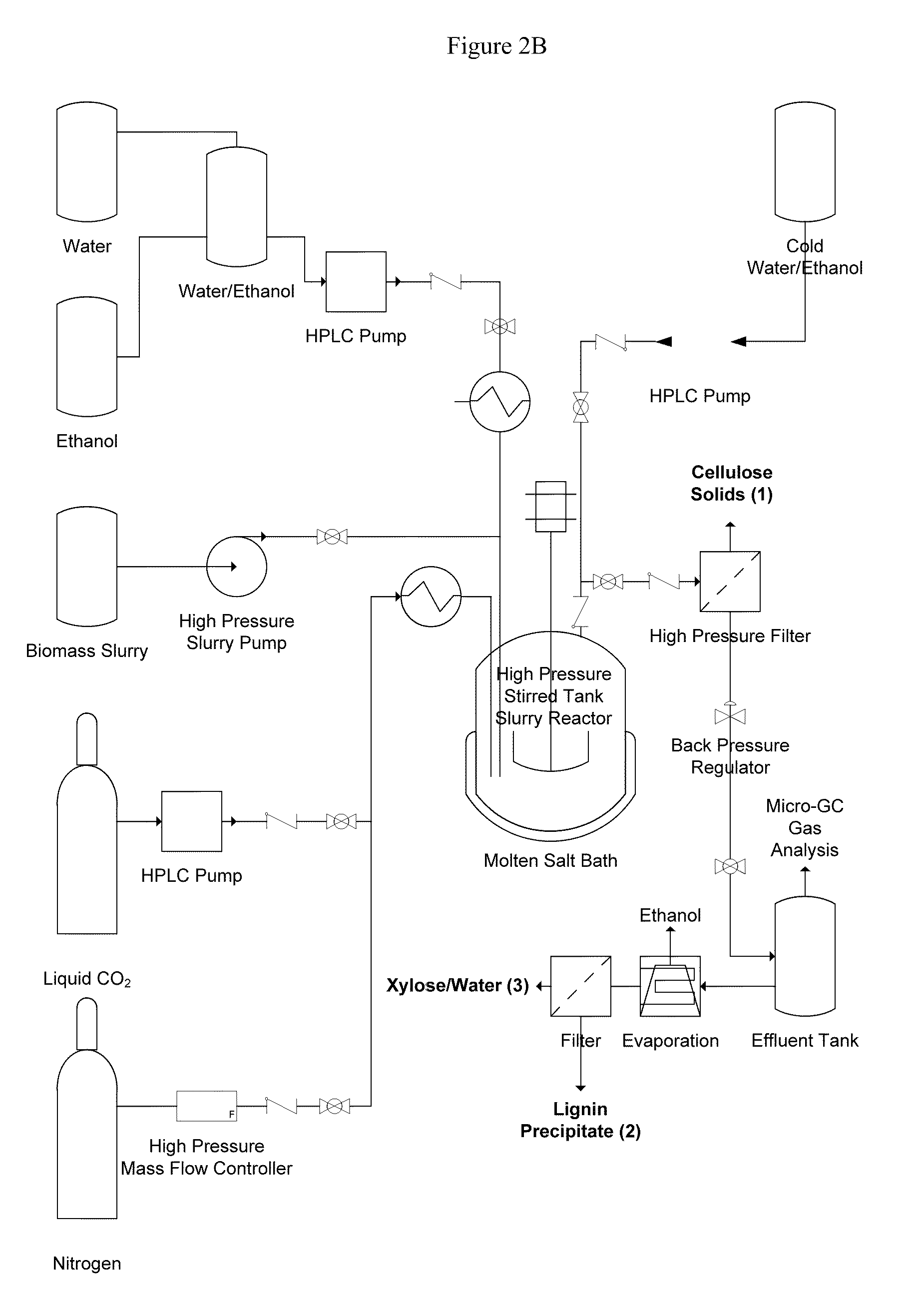Nano-catalytic-solvo-thermal technology platform bio-refineries
a technology of catalytic and thermal energy, applied in the direction of gas-gas reaction process, lignin derivative, bulk chemical production, etc., can solve the problems of limited production capacity of many processes directed to convert biomass into fuel or industrial chemicals, difficult to render cellulose present in most biomass sources accessible to reaction, and low biomass processing efficiency
- Summary
- Abstract
- Description
- Claims
- Application Information
AI Technical Summary
Benefits of technology
Problems solved by technology
Method used
Image
Examples
example 1
A Semi-Batch Process for Biomass Fractionation
[0161]Corn stover was obtained from the National Renewable Energy Laboratory (NREL). The corn stover was processed using a grinder to produce 40 mesh corn stover. The 40 mesh particle size was found to be suitable for use in the laboratory-scale supercritical fluid extraction process.
[0162]Treatment of corn stover with supercritical ethanol-CO2 mixtures was carried out using a semi-batch reactor (see FIG. 2A). The corn stover was held in the bed 6 by a 20 micron sintered metal frit placed at the downstream end of the bed. During sand bath 4 heating up, the system was purged with nitrogen. Once at the desired temperature, ethanol / CO2 flow from the reservoir 2 was started using the HPLC pump 3, passing first through a preheating coil 5, and then through the corn stover. Solvent temperature was monitored at the bed entrance by a thermocouple. After passing through the corn stover, the solvent was expanded through a nozzle 7 to atmospheric p...
example 2
A Batch Process for Biomass Fractionation
[0167]One set of experiments were done using a 1.2 ml batch reactor made of Swagelok stainless steel tube and Techne SB-2 fluidized sand bath. Corn stover (40 mesh size) was used for this set of experiments.
[0168]Calculated amounts of 40 mesh size corn stover (1 g dry basis VF), 3 g liquid (50 / 50 wt % mixture of water and ethanol) and 5-20 wt % dry ice (based on liquid weight) were taken into the Swagelok stainless steel tube. This tube was heated in a sand bath with varying temperature (180° C. to 320° C.) and pressure (75-80 bar) for various time intervals (0.17 min to 15 min). After the heat treatment, the reaction was quenched by immersing the tube into a water bath maintained at 25° C. The reaction product mixture obtained from this treatment was filtered to obtain a solid product comprising cellulose. The filtrate was evaporated in an oven maintained at 75° C. The residual solid obtained was added to water at 60° C., and the resulting s...
example 3
Continuous Fractionation of Biomass-I
[0172]A high pressure, continuously stirred slurry reactor system is used for continuous fractionation of biomass (see FIG. 2B). The slurry reactor is of relatively large volume (100 ml) and operates at temperatures and pressures up to 350° C. and 1,100 psig. The reactor system is equipped with auxiliary systems including a high pressure process gas and liquid feeding system; a liquid product collection system; and a data monitoring and acquisition system. Samples of liquid and gas products are acquired continuously. Similar stirred reactors have been successfully used by other researchers to study hydrothermal processing of biomass (Osada M, Sato T, Watanabe M, Adschiri T, Arai K. “Low-Temperature Catalytic Gasification of Lignin and Cellulose with a Ruthenium Catalyst in Supercritical Water”Energy Fuels 2004, 18:327-333).
[0173]In this steady-state experimental setup, biomass is first mechanically treated to obtain a particle size of less than a...
PUM
| Property | Measurement | Unit |
|---|---|---|
| Temperature | aaaaa | aaaaa |
| Temperature | aaaaa | aaaaa |
| Percent by mass | aaaaa | aaaaa |
Abstract
Description
Claims
Application Information
 Login to View More
Login to View More - R&D
- Intellectual Property
- Life Sciences
- Materials
- Tech Scout
- Unparalleled Data Quality
- Higher Quality Content
- 60% Fewer Hallucinations
Browse by: Latest US Patents, China's latest patents, Technical Efficacy Thesaurus, Application Domain, Technology Topic, Popular Technical Reports.
© 2025 PatSnap. All rights reserved.Legal|Privacy policy|Modern Slavery Act Transparency Statement|Sitemap|About US| Contact US: help@patsnap.com



